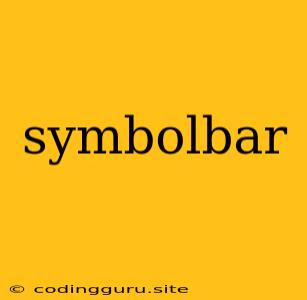What is a Symbolbar and Why Is It Important?
The symbolbar, also known as the toolbar, is a vital element in many software interfaces. It provides users with quick access to commonly used tools and functions, streamlining the workflow and enhancing user experience.
Imagine trying to navigate a word processor without the familiar symbolbar icons for bold, italic, or underline text. It would be a cumbersome and time-consuming process!
What Does the Symbolbar Include?
The contents of a symbolbar can vary depending on the software application. However, some common elements include:
- Basic Editing Tools: These are typically found in text editors and word processing software. They include icons for:
- Bold
- Italic
- Underline
- Strikethrough
- Font size and style
- Alignment (left, center, right, justify)
- Bullet points and numbered lists
- File Management: Tools for managing files, such as:
- New file
- Open file
- Save file
- Navigation: Tools for navigating through documents or web pages, such as:
- Back
- Forward
- Refresh
- Home
- Specific Functions: Many applications have specialized tools included on the symbolbar, depending on their purpose. For example, image editing software might have icons for:
- Crop
- Resize
- Rotate
- Color adjustment
Benefits of Using a Symbolbar
- Accessibility: The symbolbar provides a clear and intuitive way for users to access essential features. This is particularly important for users who are unfamiliar with keyboard shortcuts or are new to the software.
- Efficiency: By offering quick access to frequently used tools, the symbolbar streamlines the workflow, saving users time and effort.
- Consistency: The use of standardized icons on the symbolbar makes it easier for users to learn and navigate different software applications.
- Flexibility: Many symbolbars are customizable, allowing users to add or remove icons based on their individual needs.
Tips for Optimizing Your Symbolbar
- Personalization: Customize your symbolbar to include the tools you use most frequently. This makes it easier and quicker to access the functions you need.
- Clear Icons: Ensure that the icons on your symbolbar are easily recognizable and clearly represent their associated functions.
- Accessibility Considerations: When designing a symbolbar, consider accessibility for users with disabilities.
Conclusion
The symbolbar, despite its seemingly simple nature, plays a crucial role in enhancing user experience and streamlining workflows. By providing quick access to essential tools, it empowers users to work more efficiently and effectively. Whether it's a text editor, image editor, or web browser, the symbolbar is an indispensable element of modern software interfaces.
